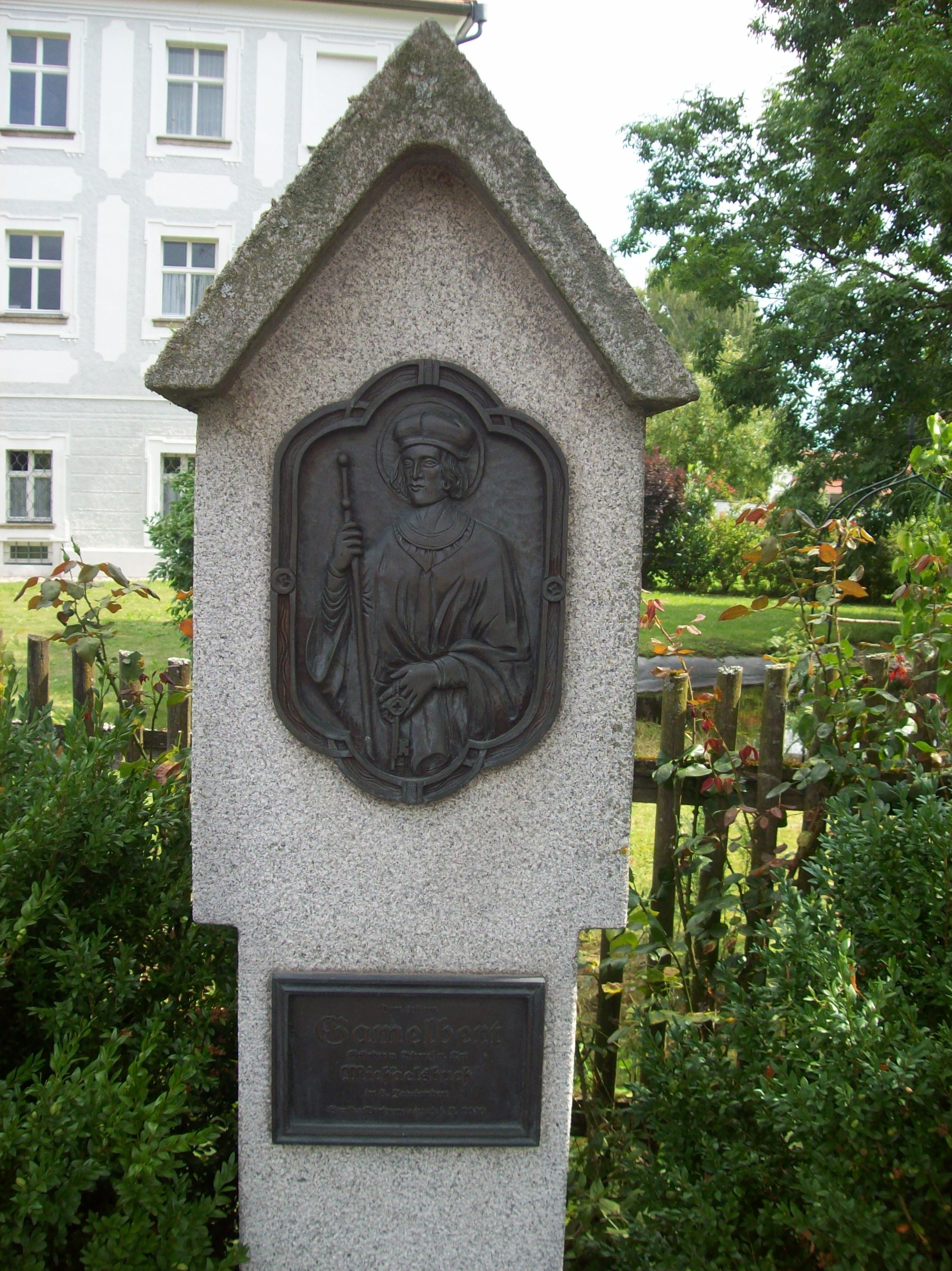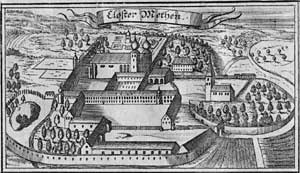|
Utto
The Blessed Utto was the first abbot of the Bavarian Metten Abbey of the Benedictine Order. His feast is celebrated on October 3. Biography Utto was presumably a monk at the abbey of Reichenau; his place of birth is unknown. According to tradition he was a relative and the godson of the priest and landlord Gamelbert in the Bavarian community Michaelsbuch, a few kilometers up from the confluence of the river Isar on the right-hand side of the Danube near the modern-day town of Plattling. As Gamelbert founded Metten Abbey on his ground around 766, he is said to have entrusted Utto with the settlement. Utto, who came from Reichenau to Metten together with twelve other monks was appointed the first abbot of the abbey. The name Abbot Utto of Metten appears in 772 in the Verbrüderungsbuch (a German register of medieval abbeys) of the synod of Dingolfing and in 784 in the Verbrüderungsbuch of St. Peter's Archabbey in Salzburg. He died on October 3, 829 in Metten Abbey. Legend Ac ... [...More Info...] [...Related Items...] OR: [Wikipedia] [Google] [Baidu] |
Gamelbert
The Blessed Gamelbert was a Christian priest, who worked in the 8th century in the area of the present Deggendorf in Bavaria in Germany. Life Gamelbert is said to have been of noble descent and a lord of Michaelsbuch. In the mid-8th century he acquired from Duke Tassilo III a piece of woodland on the opposite bank of the Danube between Mariaposching and Deggendorf, for which he had to pay a tax known as the ''Medema''. From this was derived the name of Metten both for the place itself and for the monastery, Metten Abbey, that was founded there. The first abbot was Gamelbert's godson Utto, who directed the construction of the monastery from his hermitage (the present Uttobrunn). In 766 twelve monks arrived from Reichenau Abbey Reichenau Abbey was a Benedictine Order, Benedictine monastery on Reichenau Island (known in Latin as Augia Dives). It was founded in 724 by the itinerant Saint Pirmin, who is said to have fled Spain ahead of the Moorish invaders, with patronage ... ... [...More Info...] [...Related Items...] OR: [Wikipedia] [Google] [Baidu] |
Metten Abbey
Metten Abbey, or St. Michael's Abbey at Metten (in German Abtei Metten or Kloster Metten) is a house of the Benedictine Order in Metten near Deggendorf, situated between the fringes of the Bavarian Forest and the valley of the Danube, in Bavaria in Germany. History The abbey was founded in around 766 by Gamelbert of Michaelsbuch. For many centuries Metten was under the lordship of the Dukes and Electors of Bavaria. When Charlemagne stayed in Regensburg for three years after 788, Utto turned his abbey over to the Frankish ruler, making the Ducal Abbey a Royal Abbey. After the Carolingians became extinct, Metten was turned into an Imperial Abbey. Besides the work of land clearance in the Bavarian border territories, the monks were very active in education. Members of the abbey were not only schoolteachers, but also members of the Bavarian Academy of Science in Munich and professors of philosophy and theology in Freising and Salzburg. Gerhard, Bishop of Passau was abbot in the 10 ... [...More Info...] [...Related Items...] OR: [Wikipedia] [Google] [Baidu] |
Roman Catholic Church
The Catholic Church, also known as the Roman Catholic Church, is the largest Christian church, with 1.3 billion baptized Catholics worldwide . It is among the world's oldest and largest international institutions, and has played a prominent role in the history and development of Western civilization. O'Collins, p. v (preface). The church consists of 24 ''sui iuris'' churches, including the Latin Church and 23 Eastern Catholic Churches, which comprise almost 3,500 dioceses and eparchies located around the world. The pope, who is the bishop of Rome, is the chief pastor of the church. The bishopric of Rome, known as the Holy See, is the central governing authority of the church. The administrative body of the Holy See, the Roman Curia, has its principal offices in Vatican City, a small enclave of the Italian city of Rome, of which the pope is head of state. The core beliefs of Catholicism are found in the Nicene Creed. The Catholic Church teaches that it is t ... [...More Info...] [...Related Items...] OR: [Wikipedia] [Google] [Baidu] |
Middle Ages
In the history of Europe, the Middle Ages or medieval period lasted approximately from the late 5th to the late 15th centuries, similar to the post-classical period of global history. It began with the fall of the Western Roman Empire and transitioned into the Renaissance and the Age of Discovery. The Middle Ages is the middle period of the three traditional divisions of Western history: classical antiquity, the medieval period, and the modern period. The medieval period is itself subdivided into the Early Early may refer to: History * The beginning or oldest part of a defined historical period, as opposed to middle or late periods, e.g.: ** Early Christianity ** Early modern Europe Places in the United States * Early, Iowa * Early, Texas * Early ..., High Middle Ages, High, and Late Middle Ages. Population decline, counterurbanisation, the collapse of centralized authority, invasions, and mass migrations of tribes, which had begun in late antiquity, continued i ... [...More Info...] [...Related Items...] OR: [Wikipedia] [Google] [Baidu] |
German Benedictines
German(s) may refer to: * Germany (of or related to) **Germania (historical use) * Germans, citizens of Germany, people of German ancestry, or native speakers of the German language ** For citizens of Germany, see also German nationality law German nationality law details the conditions by which an individual holds German nationality. The primary law governing these requirements is the Nationality Act, which came into force on 1 January 1914. Germany is a member state of the Europ ... **Germanic peoples (Roman times) * German language **any of the Germanic languages * German cuisine, traditional foods of Germany People * German (given name) * German (surname) * Germán, a Spanish name Places * German (parish), Isle of Man * German, Albania, or Gërmej * German, Bulgaria * German, Iran * German, North Macedonia * German, New York, U.S. * Agios Germanos, Greece Other uses * German (mythology), a South Slavic mythological being * Germans (band), a Canadian rock band * Ger ... [...More Info...] [...Related Items...] OR: [Wikipedia] [Google] [Baidu] |
Romanesque Art
Romanesque art is the art of Europe from approximately 1000 AD to the rise of the Gothic style in the 12th century, or later depending on region. The preceding period is known as the Pre-Romanesque period. The term was invented by 19th-century art historians, especially for Romanesque architecture, which retained many basic features of Roman architectural style – most notably round-headed arches, but also barrel vaults, apses, and acanthus-leaf decoration – but had also developed many very different characteristics. In Southern France, Spain, and Italy there was an architectural continuity with the Late Antique, but the Romanesque style was the first style to spread across the whole of Catholic Europe, from Sicily to Scandinavia. Romanesque art was also greatly influenced by Byzantine art, especially in painting, and by the anti-classical energy of the decoration of the Insular art of the British Isles. From these elements was forged a highly innovative and coherent s ... [...More Info...] [...Related Items...] OR: [Wikipedia] [Google] [Baidu] |
Crosier
A crosier or crozier (also known as a paterissa, pastoral staff, or bishop's staff) is a stylized staff that is a symbol of the governing office of a bishop or abbot and is carried by high-ranking prelates of Roman Catholic, Eastern Catholic, Eastern Orthodox, Oriental Orthodox, and some Anglican, Lutheran, United Methodist and Pentecostal churches. In Western Christianity the usual form has been a shepherd's crook, curved at the top to enable animals to be hooked. In Eastern Christianity, it is found in two common forms: tau-shaped, with curved arms, surmounted by a small cross; or a pair of sculptured serpents or dragons curled back to face each other, with a small cross between them. Other typical insignia of prelates are the mitre, the pectoral cross, and the episcopal ring. History The origin of the crozier as a staff of authority is uncertain, but there were many secular and religious precedents in the ancient world. One example is the lituus, the traditio ... [...More Info...] [...Related Items...] OR: [Wikipedia] [Google] [Baidu] |
Michael (archangel)
Michael (; he, מִיכָאֵל, lit=Who is like El od, translit=Mīḵāʾēl; el, Μιχαήλ, translit=Mikhaḗl; la, Michahel; ar, ميخائيل ، مِيكَالَ ، ميكائيل, translit=Mīkāʾīl, Mīkāl, Mīkhāʾīl), also called Saint Michael the Archangel, Saint Michael the Taxiarch in Orthodoxy and Archangel Michael is an archangel in Judaism, Christianity, Islam and the Baha'i faith. The earliest surviving mentions of his name are in 3rd- and 2nd-century BC Jewish works, often but not always apocalyptic, where he is the chief of the angels and archangels and responsible for the care of Israel. Christianity adopted nearly all the Jewish traditions concerning him, and he is mentioned explicitly in Revelation 12:7–12, where he does battle with Satan, and in the Epistle of Jude, where the author denounces heretics by contrasting them with Michael. Second Temple Jewish writings The earliest surviving mention of Michael is in a 3rd century BC Jew ... [...More Info...] [...Related Items...] OR: [Wikipedia] [Google] [Baidu] |
Charlemagne
Charlemagne ( , ) or Charles the Great ( la, Carolus Magnus; german: Karl der Große; 2 April 747 – 28 January 814), a member of the Carolingian dynasty, was King of the Franks from 768, King of the Lombards from 774, and the first Emperor of the Romans from 800. Charlemagne succeeded in uniting the majority of western and central Europe and was the first recognized emperor to rule from western Europe after the fall of the Western Roman Empire around three centuries earlier. The expanded Frankish state that Charlemagne founded was the Carolingian Empire. He was canonized by Antipope Paschal III—an act later treated as invalid—and he is now regarded by some as beatified (which is a step on the path to sainthood) in the Catholic Church. Charlemagne was the eldest son of Pepin the Short and Bertrada of Laon. He was born before their canonical marriage. He became king of the Franks in 768 following his father's death, and was initially co-ruler with his brother ... [...More Info...] [...Related Items...] OR: [Wikipedia] [Google] [Baidu] |
Salzburg
Salzburg (, ; literally "Salt-Castle"; bar, Soizbuag, label=Austro-Bavarian) is the fourth-largest city in Austria. In 2020, it had a population of 156,872. The town is on the site of the Roman settlement of ''Iuvavum''. Salzburg was founded as an episcopal see in 696 and became a seat of the archbishop in 798. Its main sources of income were salt extraction, trade, and gold mining. The fortress of Hohensalzburg, one of the largest medieval fortresses in Europe, dates from the 11th century. In the 17th century, Salzburg became a center of the Counter-Reformation, with monasteries and numerous Baroque churches built. Salzburg's historic center (German: ''Altstadt'') is renowned for its Baroque architecture and is one of the best-preserved city centers north of the Alps. The historic center was enlisted as a UNESCO World Heritage Site in 1996. The city has three universities and a large population of students. Tourists also visit Salzburg to tour the historic center and the sc ... [...More Info...] [...Related Items...] OR: [Wikipedia] [Google] [Baidu] |


.jpg)

.jpg)

